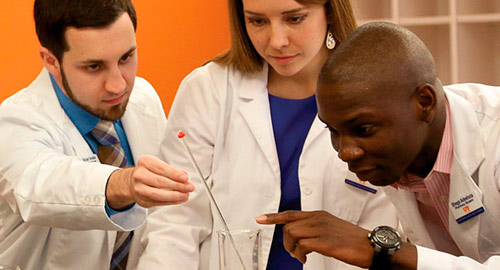
Doctor of Pharmacy (PharmD) Degree
Pharmacists: One of the Most Trusted Health Care Professionals
In 2013, pharmacists were rated as the second highest "most trusted'' professional, second only to nurses. UT Tyler now offers students the opportunity to become the No. 1 and No. 2 "most trusted" professionals with the opening of the Ben and Maytee Fisch College of Pharmacy.
Students admitted to the UT Tyler Ben and Maytee Fisch College of Pharmacy will be part of an exciting career -- and a brand new college of pharmacy!
Students will:
- Be an active participant in the classroom using team-based learning.
- Experience the practice of pharmacy, starting with the first semester of the program!
- Advocate for health promotion and disease prevention through patient education and health screenings.
- Provide safe and effective pharmacy care by combining drug therapy knowledge, pathophysiology and respect for every patient.
Learn more from the UT Tyler Ben and Maytee Fisch College of Pharmacy.
More Information
-
What Career Options are Available for Pharmacists?
There are multiple career options for pharmacists after graduation. An excellent resource for learning about different careers in pharmacy includes Pharmacy is Right for Me and the American Pharmacists Association Career Pathway Evaluation Program for Pharmacy.
Additional information for prospective students.
Marketable Skills for Pharmacists
For information about skills in pharmacy that are most sought after by employers in today's job market, visit Marketable Skills for the College of Pharmacy.
Ben and Maytee Fisch College of Pharmacy
Office of Student Affairs;
WT Brookshire Hall, Room 120
903.565.5621
pharmacy@uttyler.edu
More Information
-
UT Tyler's Doctor of Pharmacy (PharmD) Program
Pre-pharmacy coursework includes a minimum of two years of study.
Students apply for admission to the PharmD program the year before they plan to enter the program.
Students then complete four years of professional level study as part of the PharmD program.
Pharmacy graduates are then eligible for national licensing exams to become a practicing pharmacist.

Career Outlook for PharmD Graduates.
Nationally, the U.S. Bureau of Labor Statistics predicts that the demand for pharmacists will increase 14% from 2012 to 2022; this is higher than the national average for other occupations (11%).
The Texas Health Professions Resource Center* evaluated the number of pharmacists per 100,000 people from 2002 to 2011. There were fewer pharmacists per capita in rural counties as compared to metropolitan counties. Additionally, 41% of Texas counties had fewer pharmacists in 2011 than they had in 2002. In fact, 12% of counties had 0-1 pharmacists for every 100,000 people.
*Health Professions Resource Center. Supply Trends Among Licensed Health Professions, Texas, 1980-2011. 5th Edition. Austin: Texas Department of State Health Services, Jan 2012. Print No. 25-11847, E Publication No. 25-11847.

